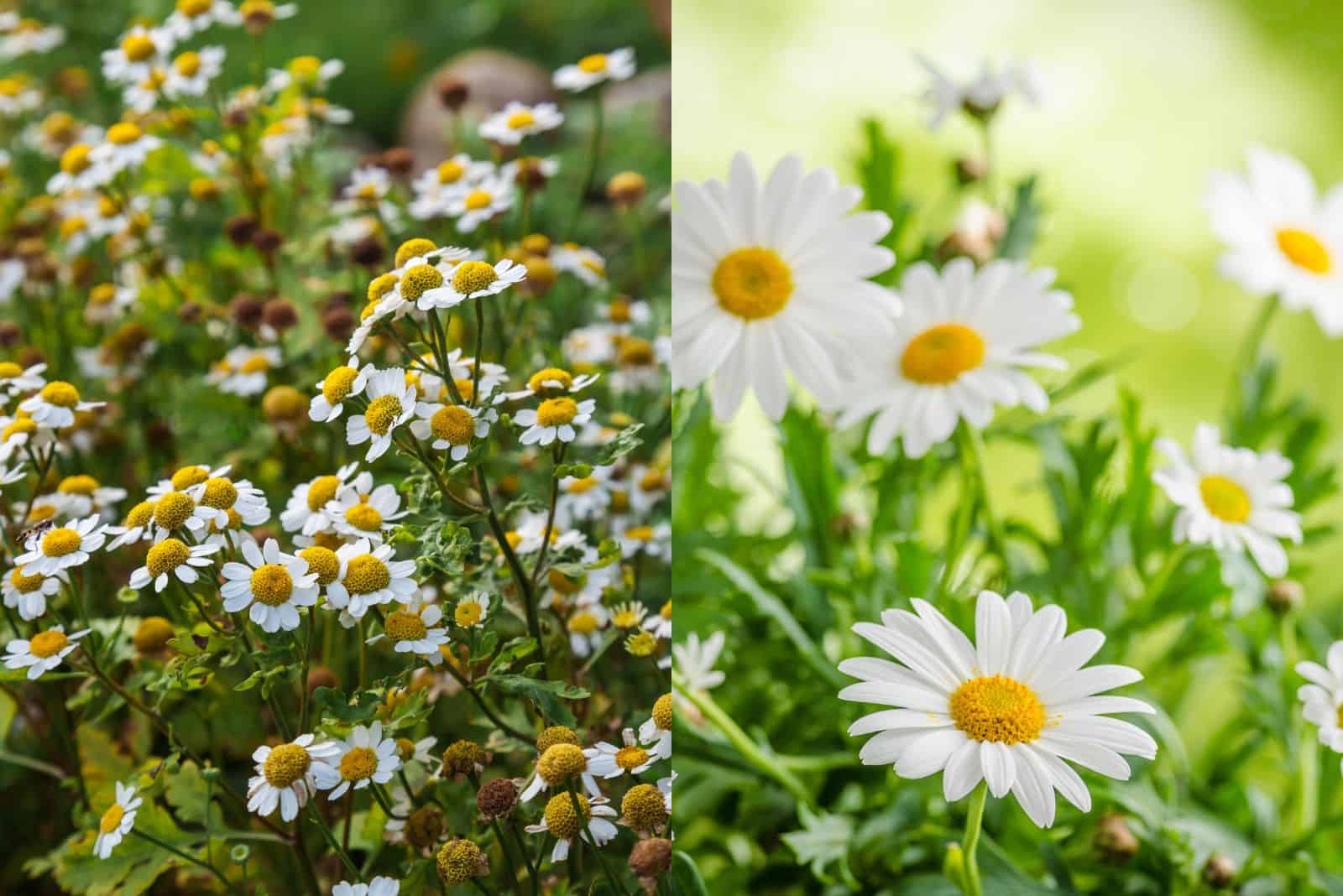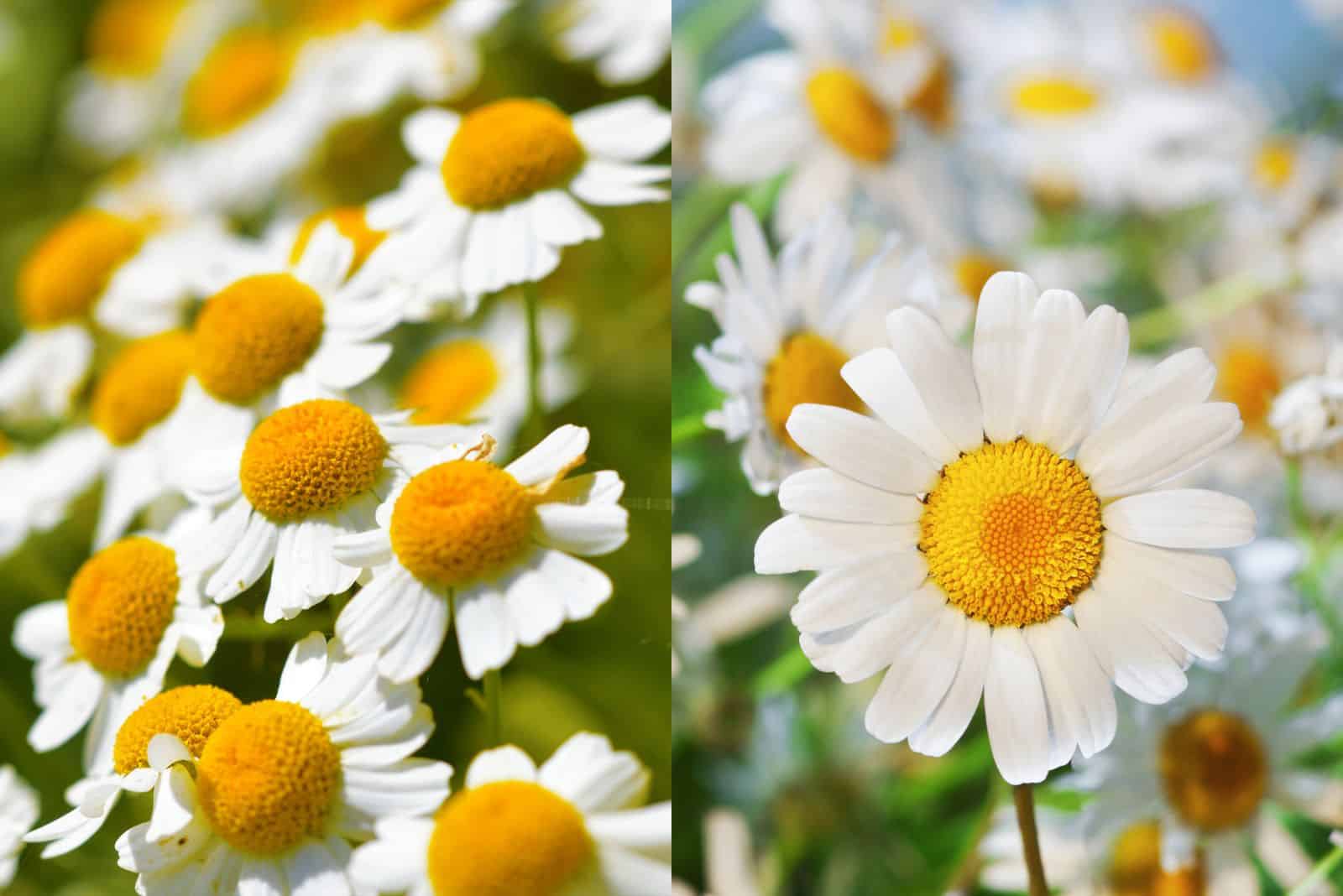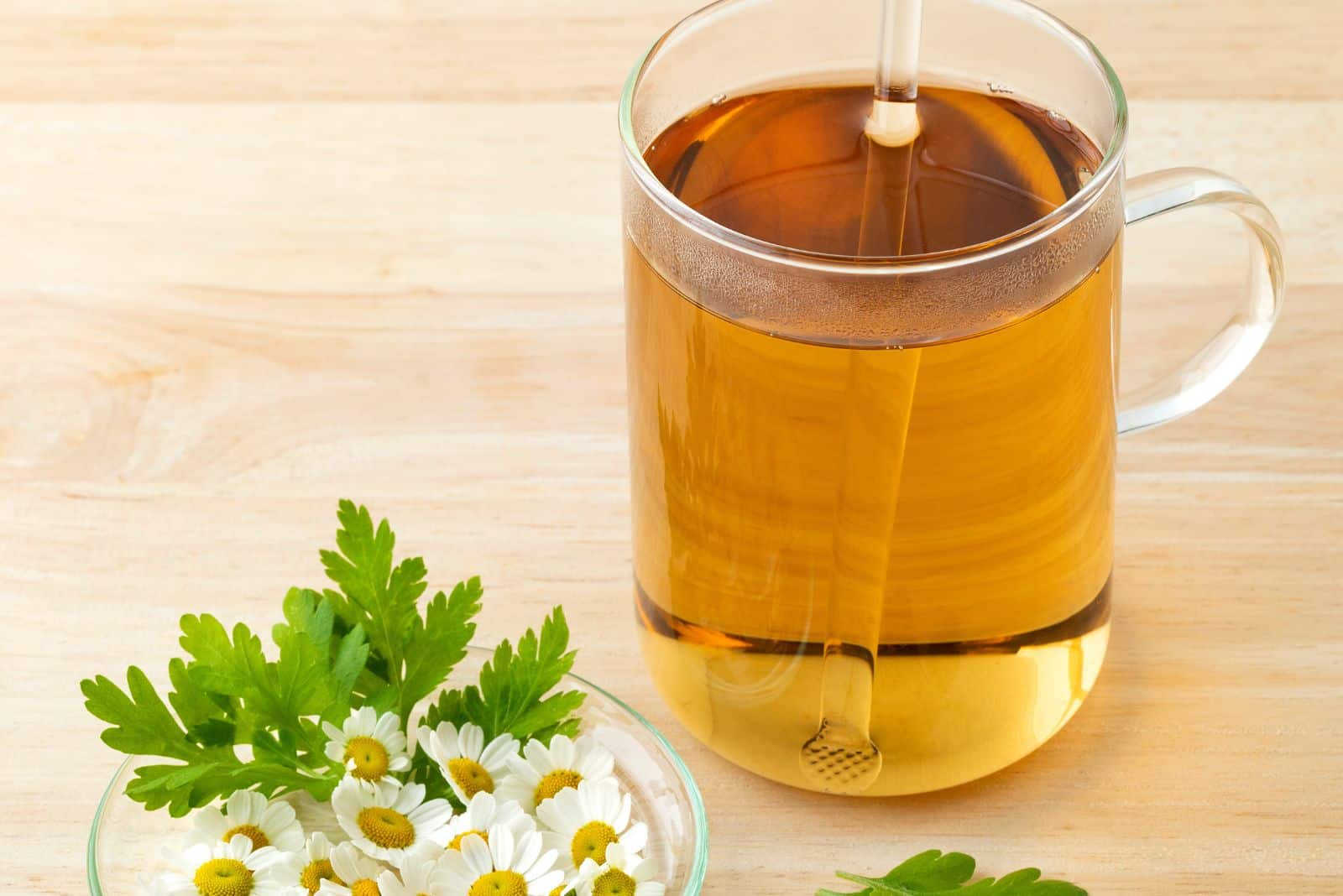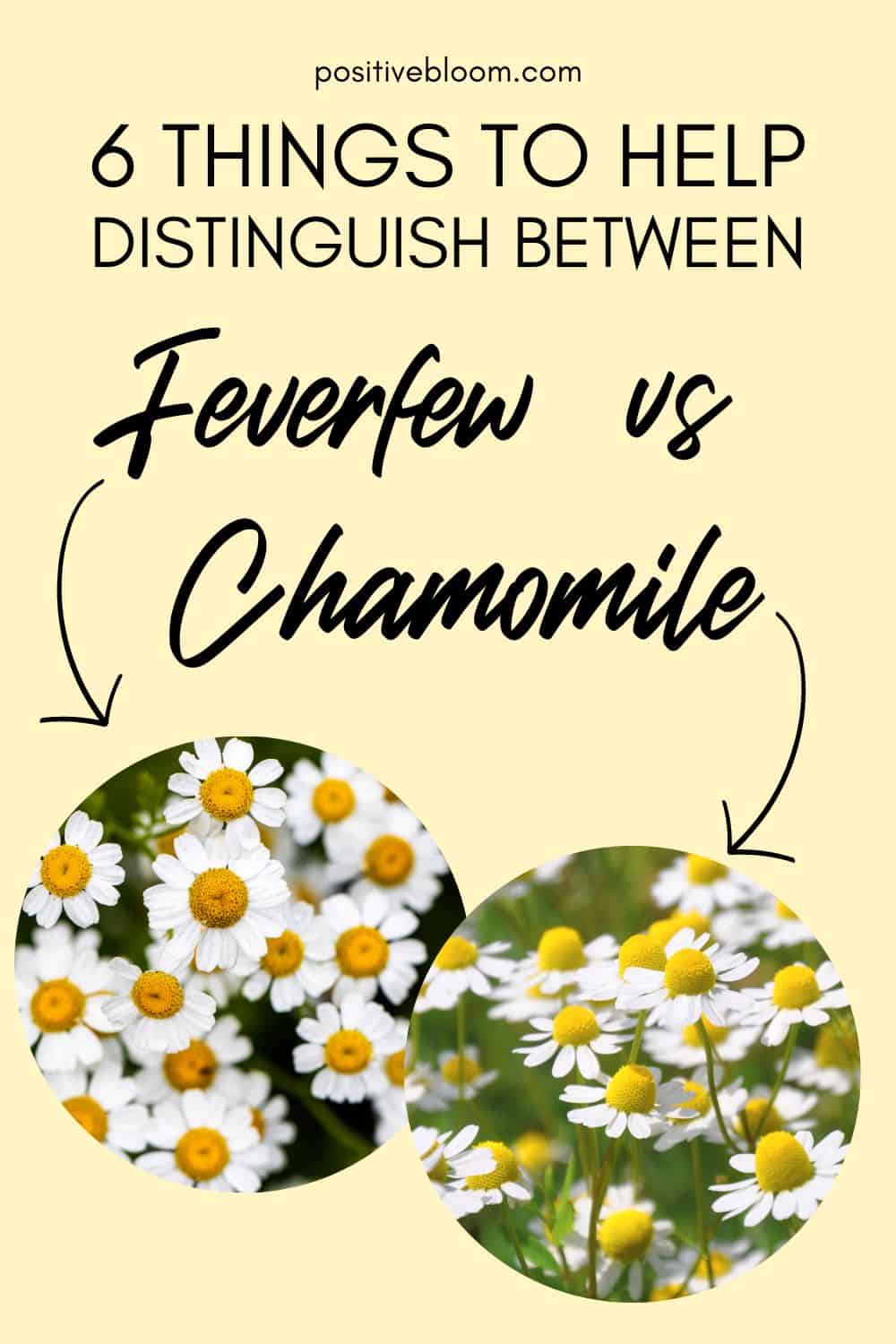We are always looking for natural remedies whenever we can’t sleep, have a headache, stomachache, or even back pain.
But what’s that got to do with this article?
Well, both feverfew and chamomile plants have proven medical benefits for some of the issues mentioned above, but it’s important to know that these plants aren’t the same.
Even though they have similar flowers, the differences between feverfew vs chamomile are myriad, such as their medicinal application, growth habit, availability, etc.
Of course, there are also certain things that connect these flowering plants, and thankfully one of those things is their care guide, which is virtually the same.
Let’s dive right in!
Feverfew vs Chamomile
Every chart for herb companion planting contains chamomile and tells of how amazing it is at deterring mosquitoes and carrot flies, and attracting beneficial insects.
But what about feverfew? Have you ever even heard of it?
Well, this herb is less known and available to the broad population than chamomile plants, but that’s not the only difference between these varieties.
The main difference is in their application; feverfew is used to treat migraine headaches, whereas chamomile is more of a sleep aid.
But there are some other things that divide these herbs, and we’ll discuss them below.
Taxonomy
One of the first things that amateur botanists notice is the difference in the names. Both plants belong to the Asteraceae family (along with daisies, chrysanthemums, calendula, marigolds, sunflowers, etc.).
However, these plants come from different genera. The scientific name of chamomile is Matricaria chamomilla (also known by the names Matricaria recutita and Chamomilla recutita (L.) Rauschert).
This particular variety is widely known by its more common names, German chamomile and wild chamomile.
Feverfew, on the other hand, is referred to as Tanacetum parthenium.
Growth Habit
These two medicinal herbs aren’t only divided by their names: chamomile plants are usually annuals, whereas feverfew is a perennial.
However, Roman chamomile is a perennial plant that thrives in USDA hardiness zones 5-9.
Chamomile is also hardier than feverfew and can tolerate USDA zones 2-9, while feverfew is hardy in zones 5-10.
Fragrance And Taste
Even though they look the same, the scent and flavor of these herbs are very different. Chamomile has a fragrance that reminds of apple blossoms and a sweet taste that goes along with it.
Feverfew, on the other hand, has a citrusy and almost bitter scent, so it’s not surprising that its taste is much sharper than that of chamomile.
Foliage
There are two main differences between feverfew and chamomile leaves.
The first one is concerned with their shape. Chamomile foliage is denser and can even obtain that fuzzy and fluffy look we’re all familiar with.
At the same time, feverfew leaves are much wider and resemble parsley.
The other difference concerns their chemical structure. Feverfew foliage contains large quantities of parthenolide, the main active ingredient from which all its beneficial properties come.
That’s why feverfew leaves are used for making tea.
Chamomile plants also contain this compound, but in much smaller quantities, which is why they’re not as helpful as feverfew varieties for treating migraine attacks.
Application
The feverfew plant has many health benefits. The main active ingredient in feverfew plants is parthenolide, which is proven to help with migraines. It’s also supposed to help with stomach issues, gum pain and toothaches, prevent insect bites, treat itchy skin, etc.
Based on the research conducted by Snezana Agatonovic-Kustrin, feverfew is an excellent migraine prophylactic. It can be used as a preventive treatment, but more inquiries need to be made into chamomile and its benefits regarding this condition.
The latter plant is therefore used for stress relief, relaxation, as a sleep aid, a digestive relaxant, for stomach issues such as vomiting, motion sickness, diarrhea, etc.
The original author, Agatanovic-Kustrin, also maintains that chamomile contains matricin and bisabolol, which are mostly found in flowers and have anti-inflammatory properties.
Both plants are used to make herbal tea, but feverfew tea is made out of its leaves, while people usually make chamomile tea using chamomile flowers.
Availability
Feverfew is primarily native to the Balkans, but can now be found all over Europe, in China and Japan, Australia, and North America.
Chamomile is more widespread, at least regarding its native habitat. This plant originates from all over the world, or rather from Europe, Africa, and Asia, but now it can be found in many North American regions.
And that’s where the difference in their availability comes from. Feverfew is much more difficult to find and, therefore, more expensive. Of course, you can find it from online herb and spice shops, but regular shops don’t usually sell them.
Chamomile, on the other hand, can be found everywhere, including herb and spice shops, grocery stores, health food stores, and maybe even on that small patch of green in front of your house!
Feverfew vs Chamomile: Similarities
Even though these two plants are quite different and aren’t usually used to treat the same issues, there are certain similarities between them.
Their flowers are similar, they both self-seed, and they both have a similar care guide that you can follow to get that natural connectivity that stems from organic gardening.
Let’s find out more.
Reproduction
Both of these plants are self-seeding, and there is a chance that they might invade your garden. However, you can easily prevent this and deadhead their flower heads after they grow paler.
But self-seeding isn’t always a bad thing. You can let these plants propagate themselves and enjoy a larger batch of feverfew leaves next season.
All you’ve got to do is remove some of the pale blossoms, but not all of them. That way, you’ll prevent them from suffocating your other plants, but will still be able to enjoy the delicious concoction you can make from them.
Flowers
The flowers of these plants are the main source of confusion. They are composed of white petals and a yellow (or orange) hill in the center of the flower head.
Both plants contain bisabolol and chamazulene in their blossoms, although the concentration of these active ingredients is higher in chamomile flowers.
Plant Care
We always say that if you want high-quality and organic fruit, vegetables, and herbs, you should grow them yourselves. The taste is incomparable.
It goes without saying that growing these herbs in your own garden will provide you with fresh leaves and flowers for the best tea.
Furthermore, you can also try growing some chamomile companion plants, such as tomatoes, cole crop (broccoli, brussels sprouts), and cucurbits (cucumber, melons) near this herb as it can deter pests and attract beneficial insects.
Let’s learn more about the requirements of these herbs.
Light Requirements
Both herbs thrive in locations that get full sun, but they can tolerate some shade if you grow them in particularly hot regions.
In that case, ensure they are protected during the hottest times of day, while exposing them to direct sunlight in the morning and afternoon.
Water And Humidity
Feverfew and chamomile cannot tolerate drought when they’re young, so make sure you keep the substrate consistently moist until they mature.
As the plants grow, they become more and more drought-tolerant and can eventually survive only on rainfall.
However, if you live in an arid region, you should irrigate these herbs a couple of times a week and provide them with an inch of water per week.
Neither of the plants has special humidity requirements, so you can grow them wherever you want, just pay attention to their temperature requirements, which we’ll discuss below.
Temperature
Chamomile and feverfew plants thrive in temperate climates where temperatures are usually between 45-80˚F.
However, both plants can tolerate much cooler conditions, and feverfew can survive temperatures as low as -20˚F.
Chamomile is usually grown as an annual, so it never really sees the winter, but it can survive cooler springs with temperatures down to 30˚F (most plants need warmer conditions to grow when young).
Soil And Fertilizer
Both herbs prefer slightly acidic and well-draining soils. The growing medium should be rich in nutrients and organic matter for optimal growth.
Furthermore, if the substrate is fertile, you won’t have to feed your plants any extra, but if your soil could use more nutrients, you can apply some organic, all-purpose fertilizer in the early spring.
FAQ
We discussed many things concerning the differences and similarities between feverfew vs chamomile, but that’s not all!
We found some interesting questions you asked us and will answer them in the following paragraphs.
How do you make feverfew tea?
Add one teaspoon of feverfew leaves to about a cup of water and let it steep for at least five minutes. Discard the leaves and drink three cups a day, unless you take any medications, are pregnant, etc.
(Some experts recommend steeping any tea leaves for 15 minutes so that you can reap all the benefits.)
Is there another plant that looks like chamomile?
There are a few different plants that resemble chamomile, and some of them are fennel, pineapple weed, false chamomile (or scentless false mayweed), stinking chamomile, feverfew, etc.
Final Thoughts
This article discussed the differences between feverfew vs chamomile, the main one of which is in their application.
Feverfew is mainly used to prevent and treat migraines, whereas we use chamomile as a sleep aid or a relaxant.
However, there are more differences between the plants, such as their availability (chamomile is widely available, and feverfew not so much), growth habits, names, etc.
But even though there are so many things that divide them, they aren’t entirely different. These herbs have similar flowers and care guides, so you can grow them together in your own garden.
Enjoy their medicinal applications, and until next time!
Like this post? Share or pin it for later!





